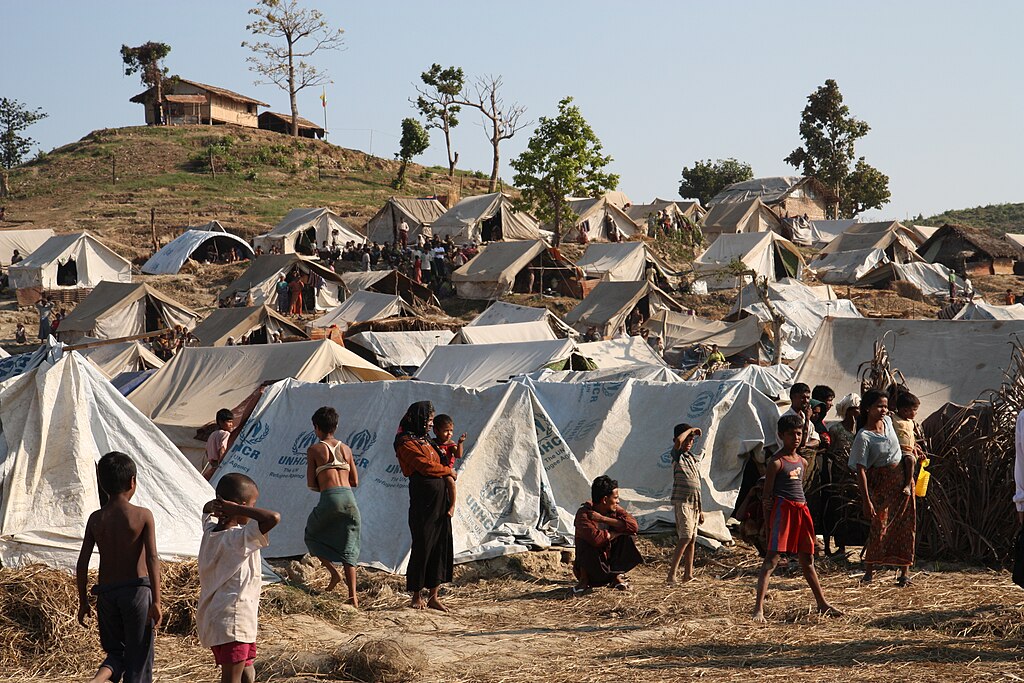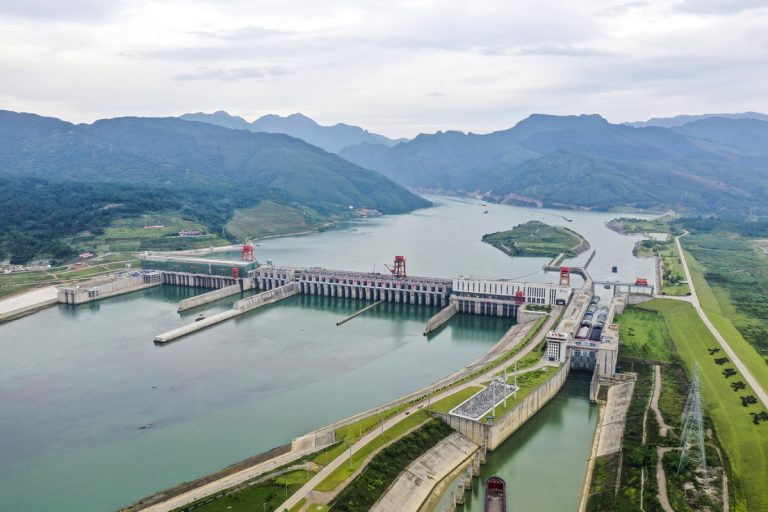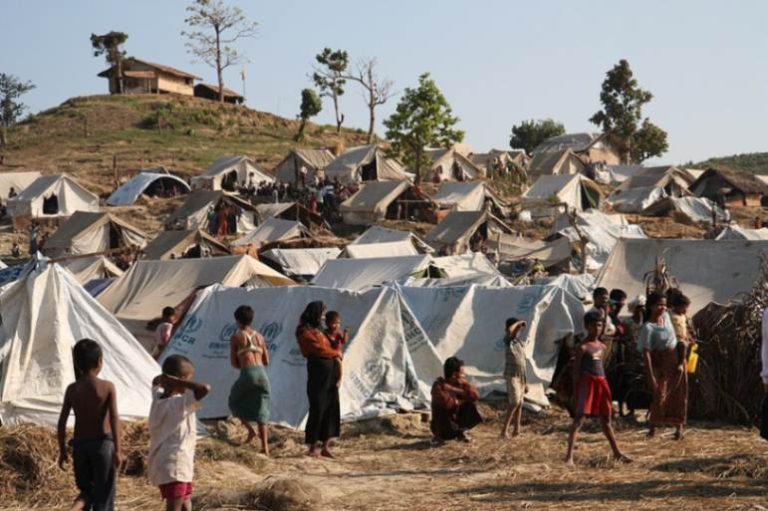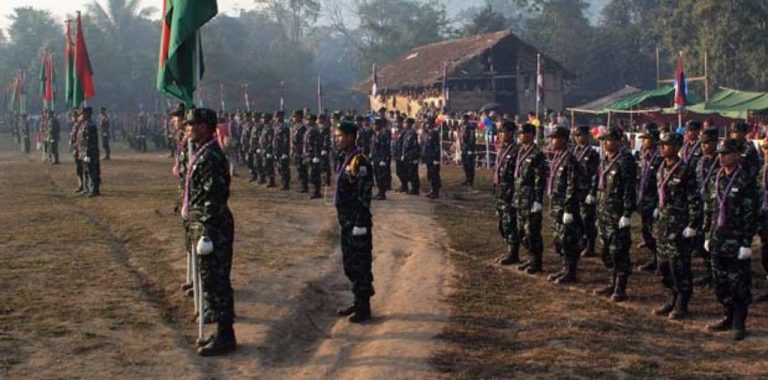
Over the previous year, between 60,000 and 80,000 Rohingya refugees have entered Bangladesh from Myanmar’s Rakhine State, fleeing from the persecution of the Arakan Army, a Rakhine nationalist ethnic armed organization (EAO) ascendant in the region. This, coupled with other hostile actions of the Arakan Army, presents Bangladesh with a new political and security challenge in its southeastern periphery. As the Rohingya refugee crisis becomes increasingly protracted with no solution in sight, and as all diplomatic, political, and legal options are exhausted, Bangladesh may have to contemplate alternative options for the repatriation of the Rohingyas, utilizing the emergence of a curious political and legal vacuum in the conflict-torn and contested Rakhine State.
Background
The Rakhine State, historically known as Arakan, is populated by two major ethnic groups — the Rakhines and the Rohingyas. The numerically larger and primarily Buddhist Rakhines are concentrated in southern and central Rakhine State, while the numerically smaller and primarily Muslim Rohingyas constitute the majority of the population in northern areas of the state, namely, the Maungdaw District. These two racially, culturally, linguistically and denominationally distinct ethnic groups have shared hostile relations since the Second World War, and engaged in frequent interethnic clashes. Meanwhile, the ethnic Bamar-dominated Myanmar central government has been locked into conflict with both the Rakhines and the Rohingyas since the inception of the Myanmar state in 1948, with Rakhine and Rohingya EAOs demanding autonomy or independence.
State-orchestrated campaigns of ethnic cleansing and intercommunal conflicts with the Rakhines have repeatedly forced the Rohingyas to take shelter in Bangladesh, particularly in 1978, 1991–1997, 2012, 2015, and 2016–2018. By the onset of 2024, Bangladesh hosted more than 1.3 million Rohingya refugees. Meanwhile, since the start of Operation 1027, the Arakan Army has inflicted several military defeats on the Myanmar government forces, and captured the Paletwa Township of the Chin State, as well as more than 80% of the territory of the Rakhine State, including the Rohingya-populated Maungdaw District and the entire length of the Bangladesh–Myanmar border. Since early 2024, the Arakan Army’s atrocities against Rohingya civilians, including murder, arson, and extortion, have forced between 60,000 and 80,000 Rohingyas to flee to Bangladesh. Thus, the prolonged conflict in the Rakhine State has created a massive and protracted refugee crisis for Bangladesh.
Effects of the Rohingya Crisis on Bangladesh
The Rohingya refugee crisis in Bangladesh has been, first and foremost, a humanitarian disaster, with some 1.4 million Rohingyas living in refugee camps in the Teknaf and Ukhia Sub-districts under the Cox’s Bazar District and the Bhasan Char Island in the Hatiya Sub-district under the Noakhali District. The stateless Rohingyas are confronted with every possible misery: extreme poverty, malnutrition, diseases, absence of adequate educational, healthcare, and hygienic facilities, crimes, and lack of civil, political, social, and cultural rights. Also, the crisis has imposed huge economic and financial costs on Bangladesh, while the international community is gradually losing interest in sharing the financial burden of supporting the refugees.
Meanwhile, desperate Rohingya refugees are involved in myriad criminal activities, including murder, rape, robbery, drug smuggling, prostitution, and kidnapping, and rival Rohingya armed groups engage in violent conflict with one another to assert dominance in the refugee camps, seriously disrupting social order. Moreover, the influx of low-cost Rohingya labour into the local job market has depressed wages for host communities, while the presence of numerous foreigners, primarily employees of international organizations (IOs) and non-government organizations (NGOs) has spiked housing costs for locals, breeding tensions between the Rohingyas and the host communities. Furthermore, the influx of the Rohingyas has resulted in an environmental catastrophe in the Cox’s Bazar District through deforestation, hill cutting, water pollution, and waste mismanagement.
In addition to the extensive humanitarian, economic, financial, social, and environmental costs, the Rohingya refugee crisis poses several political and security threats to Bangladesh. The Rohingyas outnumber the local population in Teknaf and Ukhia, and if the refugee crisis remains unresolved, the region can become a hotspot for instability in future. Also, the movement of some Rohingyas to the restive and ethnically mixed Chattogram Hill Tracts (CHT) has the potential to spark off a large-scale ethnic conflict, while the dispersion of the Rohingyas throughout the country could further complicate the resolution of the crisis. Again, the impoverished, aimless and largely uneducated Rohingya youth can turn into a recruiting base for militant groups. Moreover, the large-scale involvement of the Rohingyas in criminal activities, particularly drug trafficking, is contributing greatly to the emergence of a miniature narco-state in southeastern Bangladesh. Taking all these factors into consideration, the resolution of the protracted Rohingya refugee crisis is a top priority for Bangladesh.
Enter the Arakan Army
The Myanmar government bears the lion’s share of the responsibility for the repeated exodus of the Rohingyas from northern Rakhine State. Yet, the Arakan Army and its political wing United League of Arakan (ULA), which have largely replaced the authority of the Myanmar government in the Rakhine State, have proved no better. The Myanmar government’s cynical use of divide and rule tactics through the forced conscription of the Rohingyas and the shadowy alliances with Rohingya EAOs has succeeded in igniting a renewed inter-ethnic conflict in the Rakhine State between the Rakhines and the Rohingyas. Violating its previous pledges to build an inclusive Rakhine State, the Arakan Army has engaged in numerous atrocities against the Rohingyas, including the murder of civilians, the burning of homes and villages, and the confiscation of money and other goods.
The Arakan Army’s actions have forced some 60,000–80,000 Rohingyas to flee to Bangladesh, further worsening the existing refugee crisis. Thus, despite its professed desire to maintain good ties with Dhaka, the Arakan Army has seriously harmed the interests of Bangladesh, which has maintained strict neutrality in the war in the Rakhine State. It should be noted that just like the Myanmar government, the Arakan Army does not recognize the distinct identity of the Rohingyas, terms them Bangladeshi immigrants, and has demonstrated little inclination to take back Rohingya refugees from Bangladesh. Moreover, the Arakan Army has killed Bangladeshi citizens, repeatedly abducted Bangladeshi fishermen, disrupted bilateral trade between Bangladesh and Myanmar, and interdicted Bangladesh-bound vessels. Thus, the activities of the Arakan Army can hardly be described as ‘friendly’ towards Bangladesh.
Contemplating a Realpolitik Solution
So far, Bangladesh has used every possible peaceful option for the repatriation of Rohingya refugees, but to no avail. Dhaka has engaged in bilateral negotiations with the Myanmar government, accepted Chinese mediation, urged other third parties (such as the Western World and India) to intervene, presented concrete proposals at the United Nations (UN), and indirectly backed genocide cases against Myanmar at international courts. However, despite Dhaka’s painstaking efforts, not a single Rohingya refugee has yet been repatriated to Myanmar. Taking into account Myanmar’s current military-political situation and the international environment, it is unlikely that diplomatic, political, or legal measures would succeed in facilitating the repatriation of the Rohingyas to their homeland.
Thus, the only option currently available for Bangladesh to repatriate the Rohingya refugees appears to be a coercive one. There are historical precedents of repatriating refugees through coercive means. During the Bangladeshi War of Independence (1971), India forged an alliance with Bangladeshi insurgents, intervened in the country to defeat Pakistani forces, and repatriated some 9.9 million refugees to Bangladesh. During the Cambodian War (1975–1991), Vietnam overthrew the Cambodian government, installed a pro-Vietnamese government in Phnom Penh, and repatriated tens of thousands of Cambodian refugees to Cambodia. Bangladesh can contemplate a similar solution to the Rohingya refugee crisis.
At present, Myanmar in general and the Rakhine State in particular are in flux. The military-controlled State Administration Council (SAC) government controls the Bamar heartland, and is recognized as the legitimate government of Myanmar by the majority of the international community, including China, the Association of Southeast Asian Nations (ASEAN), India, Russia, and Bangladesh. On the other hand, the opposition National Unity Government (NUG) represents Myanmar at the UN, and is viewed as the legitimate government of Myanmar by the Western World. Meanwhile, the Arakan Army controls more than 80% of the territory, with the remainder being under control of the SAC. While some states have informally engaged with the Arakan Army, none has accorded it formal recognition, and so a power vacuum exists in most of the Rakhine State, including the Rohingya-populated northern Rakhine State.
Hypothetically, Bangladesh can exploit the power vacuum in the Rakhine State by launching a humanitarian intervention in the northern Rakhine State and repatriating the Rohingya refugees to their lands. At present, the Arakan Army controls the Rohingya-populated Maungdaw District, a strip of land spanning 3,538 km², or 9.6% of the Rakhine State. The Arakan Army is far smaller and less well-equipped than the Bangladesh Armed Forces, lack a proper navy or air force, and is currently locked into conflict against the Myanmar forces as well as Rohingya EAOs, particularly the Arakan Rohingya Salvation Army (ARSA). Through a well-planned, well-coordinated, and comprehensive combined arms operation, the Bangladesh Armed Forces can establish control over the Maungdaw District. Afterwards, 1.4 million Rohingya refugees can be resettled on their native lands, and Bangladesh can withdraw its troops to its internationally recognized borders.
To play the devil’s advocate, Bangladesh would require the cooperation of the Myanmar government and the Rohingya EAOs in implementing such plans. The Myanmar government is currently in a very weakened position in the Rakhine State, and so Bangladesh would be in a much stronger negotiating position vis-à-vis Nay Pyi Taw than it was earlier. Bangladesh should press for the repeal of the 1982 Citizenship Law of Myanmar, guaranteeing citizenship for the repatriated Rohingyas. Since Nay Pyi Taw does not have any qualms about collaborating with the Rohingya EAOs, it should not hesitate about granting citizenship to the Rohingyas and turning them into a loyal minority in its periphery. On its part, after taking control of the Maungdaw District, Bangladesh should transfer its control to the Myanmar government. Nay Pyi Taw is on the verge of losing the entire Rakhine State, so it is likely to take up the assistance offered from such unexpected quarters.
However, if Bangladesh indeed resorts to this option, it is likely to face substantial tactical-operational, political, economic, and diplomatic challenges.
First, although the Bangladesh Armed Forces has participated in numerous counter-insurgency, counter-terrorist, and peacekeeping operations, Bangladesh has not participated in any full-scale conventional war since 1971. So, the Bangladesh Armed Forces does not have any practical experience in waging modern high-intensity warfare. Also, the geography of the prospective theater poses challenges to the operation. Crossing the Naf River and conducting conventional warfare in the mountainous regions of the Maungdaw District would be quite difficult for the expeditionary force, while unfamiliarity with the terrain and lack of logistics facilities would further hamper the operation. Meanwhile, the Arakan Army is smaller in size, but it has years of experience of fighting against the well-equipped Tatmadaw, and it can count on the support of the ethnic Rakhine population in the theater.
However, extensive and rigorous training exercises, comprehensive intelligence collection, and adequate logistical preparations can surmount most of these problems. And while the Arakan Army has achieved considerable tactical successes against the Tatmadaw, the latter’s preoccupation with multiple fronts and lack of adequate manpower have contributed significantly to this outcome.
Second, while public opinion inside Bangladesh is likely to be largely favourable to a humanitarian intervention in northern Rakhine State, parts of the political, economic, cultural, and media elites are expected to oppose the move owing to their vested interests or ideological convictions. Also, a protracted and/or bloody intervention would diminish popular support for the move and act as a political dynamite for the incumbent government. Moreover, enlisting the support of the Rohingya refugees in their repatriation would be a Herculean task.
Third, an operation of this scale would be very costly, placing an additional burden on the ailing Bangladeshi economy. And if the operation is drawn-out and results in large number of casualties, the ballooning costs of the operation would create a serious socio-political crisis in Bangladesh.
So, if Dhaka wants to minimize the political and economic costs of the hypothetical intervention, the operation should be meticulously planned and efficiently executed within the span of a relatively short time.
Finally, such an intervention would certainly bring about intense international pressure, in the form of condemnations and sanctions, on Bangladesh. Given the current state of the Indo–Bangladeshi relations, New Delhi is certain to oppose any Bangladeshi move in northern Rakhine State. Since the Myanmar government shares close ties with China, Beijing is unlikely to vigorously oppose the move if the operation is conducted with Nay Pyi Taw’s connivance. However, the NUG and their Western patrons are unlikely to view positively any move that can be potentially helpful for the Myanmar government, and so they would likely be strongly opposed to the hypothetical intervention.
However, if Bangladesh succeeds in taking control of the northern Rakhine State and repatriating the Rohingya refugees rapidly, many of the international complications can be avoided. A quick end to the conflict and a rapid withdrawal of Bangladeshi forces from the territory after the completion of the operation would remove the ground for international actions against Bangladesh. Also, if Dhaka succeeds in securing the support of a great power for this move, its international position would be bolstered. Moreover, humanitarian intervention has become a norm in the international system in the post-Cold War period, with the Western World undertaking humanitarian interventions in Kosovo and Libya, and Russia justifying its interventions in Georgia and Ukraine on humanitarian grounds. In this context, the repatriation of the long-suffering Rohingyas to their homeland is a very just ground for humanitarian intervention in northern Rakhine State.
The protracted Rohingya refugee crisis has already confronted Bangladesh with serious humanitarian, economic, financial, social and environmental challenges, and the prolongation of the crisis can result in the emergence of a restive periphery, a militant haven, or a narco-state in southeastern Bangladesh. So far, Bangladesh’s diplomatic, political, and legal efforts to facilitate the repatriation of the Rohingyas have failed, and the current circumstances in the Rakhine State indicate that the situation is likely to persist in the future. Meanwhile, the hostile actions of the Arakan Army pose a new security threat to Bangladesh. Accordingly, Bangladesh may have to contemplate coercive measures to protect its national security in the southeastern direction in the future.
[Image Credit: DFID – UK Department for International Development]
Opinions expressed in this article are those of the author.




